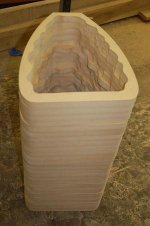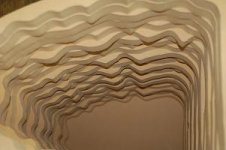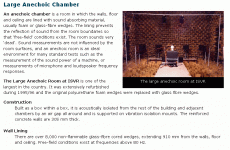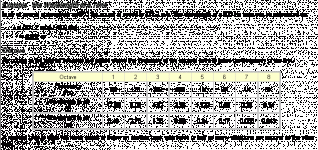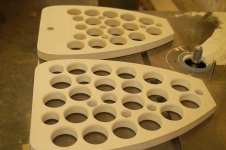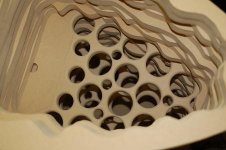Well well well. The question is: translam or not translam? Not really, I've been waiting for an opportunity to do a full size 3-way translam speaker and here it is. A friend of mine listened to some of my designs and after an hour or so decided to dump his small Sonus Faber on his cousin and splurge for some real good drivers. I said oki doki, I'll build you a pair.
Here comes the ebay and DIY forums for some great pricing.
Just got a set of 4 SS 18w/8531G-00 Revelators.
Have a pair of 25w/8565-01 stored in the box
and finally a pair of Seas Excel T25cf-003
So I am thinking: acoustic suspension BMTM crossed over at about 350hz and 2800hz with electrical 2nd order.
The impedance of the 25w is pretty high at resonance so I am curious to see how the impedance compensation including this peak would affect the sound and perhaps make an amplifiers job less stressful. I am also going to create internal cavity in the loudspeakers walls and use a heavy filler, such as powdered glass or silicon-carbide may be binded with epoxy.
I am also thinking if I should get another pair of 25w so I wouldn't have to over complicate the crossover with BSC coil.
Any thoughts?
I measure with Sound Easy, Beringer console and microphone.
Here comes the ebay and DIY forums for some great pricing.
Just got a set of 4 SS 18w/8531G-00 Revelators.
Have a pair of 25w/8565-01 stored in the box
and finally a pair of Seas Excel T25cf-003
So I am thinking: acoustic suspension BMTM crossed over at about 350hz and 2800hz with electrical 2nd order.
The impedance of the 25w is pretty high at resonance so I am curious to see how the impedance compensation including this peak would affect the sound and perhaps make an amplifiers job less stressful. I am also going to create internal cavity in the loudspeakers walls and use a heavy filler, such as powdered glass or silicon-carbide may be binded with epoxy.
I am also thinking if I should get another pair of 25w so I wouldn't have to over complicate the crossover with BSC coil.
Any thoughts?
I measure with Sound Easy, Beringer console and microphone.
This is a result of a day and a half of work. I had an option of going to someone with CNC but chose to do it the old fashion way. Jig saw, band saw and a shaper. I did see this type of the internal anechoic chamber on Tony G web site and decided to over complicate things a bit. There are 3 semi random patterns stocked up internally. I will apply sound absorbing foam to each layer before glue up.
Figuring out internal volume is also a pain. I think I'll place each type of this segments on the flat surface, fill it up flat with sand and then measure the volume of sand in a measuring glass. Then do my math. My believe is that this enclosure will be very much dead internally.
Figuring out internal volume is also a pain. I think I'll place each type of this segments on the flat surface, fill it up flat with sand and then measure the volume of sand in a measuring glass. Then do my math. My believe is that this enclosure will be very much dead internally.
Attachments
Nice! ...especially the inside surface.
Have you considered adding internal cross-bracing?
A tip: if you can still manage to do it, try to include some sort of alignment guide. IME, it is difficult to align all pieces simultaneously.
My lam project (WIP)
Have you considered adding internal cross-bracing?
A tip: if you can still manage to do it, try to include some sort of alignment guide. IME, it is difficult to align all pieces simultaneously.
My lam project (WIP)
Thanks Shaun. How's your project going?
I am planing to include bracing later on, just haven't gotten to do it yet.
I think in addition I will make a vertical cross brace.
The other idea that's really tempting it to attach the driver to bracing. Orion ++ has the driver mounted on the bracket so perhaps I could somehow utilize this idea.
I am planing to include bracing later on, just haven't gotten to do it yet.
I think in addition I will make a vertical cross brace.
The other idea that's really tempting it to attach the driver to bracing. Orion ++ has the driver mounted on the bracket so perhaps I could somehow utilize this idea.
My project runs in stops and starts. Mostly because I don't have a sheltered work area (it's winter here now). Due to some sections having slid out of alignment while gluing, I have lots of sanding/filling/plaining to do. My next best chance of getting going is the December holidays, so the translam project is on hold while I carry on with smaller projects.
The next translam project I do will definitely use plywood instead of MDF. I keep worrying about expansion and contraction of the MDF (will get it sealed thoroughly?).
Good luck with yours.
The next translam project I do will definitely use plywood instead of MDF. I keep worrying about expansion and contraction of the MDF (will get it sealed thoroughly?).
Good luck with yours.
Well, there's a specific resonance for each material such as MDF or in this case HDF. There's also a volume specific resonance for the enclosure. While a specific resonance in a rectangular chamber without stuffing or an acoustical absorbent can go as high as 60 decibel I am curious to see how this chamber will react. The measurements will be posted later on.
Now, how and based on what there's a conclusion on the size of the wedges Salas?
Now, how and based on what there's a conclusion on the size of the wedges Salas?
I make no absorbent material to specifically inform you about. There are Sabin tables for absorption coefficient VS frequency and thickness of common materials used for such purposes. Google and you shall see.
I reminded you that a wedge needs to be 1/4 to 1/2 the longest mode of interest in wavelength depending on its shape and absorption. 1/2 wavelength if hard surace. Your pattern will work far higher than your chamber has its modes. So you did lot of work for little or no return. That's all.
In the attached picture you can see the Southampton University anechoic chamber with 910mm fully absorbing wedges officially rated good above 80Hz. They are a bit optimistic still. 100Hz would be secure.
Meyer Sound states that 10 to 20 feet fully absorptive wedges would be OK for 30Hz and 38 feet dimensions. So they rate their medium size chamber for 100Hz, and go outdoors ground plane for really low free field.
Hope I gave you an idea. Nice work BTW. Keep it up.
I reminded you that a wedge needs to be 1/4 to 1/2 the longest mode of interest in wavelength depending on its shape and absorption. 1/2 wavelength if hard surace. Your pattern will work far higher than your chamber has its modes. So you did lot of work for little or no return. That's all.
In the attached picture you can see the Southampton University anechoic chamber with 910mm fully absorbing wedges officially rated good above 80Hz. They are a bit optimistic still. 100Hz would be secure.
Meyer Sound states that 10 to 20 feet fully absorptive wedges would be OK for 30Hz and 38 feet dimensions. So they rate their medium size chamber for 100Hz, and go outdoors ground plane for really low free field.
Hope I gave you an idea. Nice work BTW. Keep it up.
Attachments
Salas, We probably misunderstood each other. I understand what an anechoic chamber is and how it works. And I also understand that creating a totally dead 2.5 ft3 enclosure is impossible.
Let me finish the job, post the measurements and then we'll talk about it a bit more.
My idea is not to create a cancellation of the sound wave but rather brake it down and create multiple cancellations and eliminate standing wave as much as I can. I also always found a problem with resonating boxes with flat walls, so let's see what happens. Rite now if you flick your fingers inside, you could hear the bottom plate ringing and it's a very weird sound.
Let me finish the job, post the measurements and then we'll talk about it a bit more.
My idea is not to create a cancellation of the sound wave but rather brake it down and create multiple cancellations and eliminate standing wave as much as I can. I also always found a problem with resonating boxes with flat walls, so let's see what happens. Rite now if you flick your fingers inside, you could hear the bottom plate ringing and it's a very weird sound.
Originally posted by R-Carpenter
Rite now if you flick your fingers inside, you could hear the bottom plate ringing and it's a very weird sound.
Mine sounds like a drum (it is totally glued-up). It seems that the vertical resonance mode is going to be a problem. I have read a comment (I think by Zaph) that he has to add much stuffing at the ends to damp this resonance in tall speakers.
R-Carpenter said:Salas, We probably misunderstood each other. I understand what an anechoic chamber is and how it works. And I also understand that creating a totally dead 2.5 ft3 enclosure is impossible.
Let me finish the job, post the measurements and then we'll talk about it a bit more.
My idea is not to create a cancellation of the sound wave but rather brake it down and create multiple cancellations and eliminate standing wave as much as I can. I also always found a problem with resonating boxes with flat walls, so let's see what happens. Rite now if you flick your fingers inside, you could hear the bottom plate ringing and it's a very weird sound.
I understand your idea. You want to diffuse internally. But the real problem are the modal resonant notes. Your diffused frequency range by your pattern is going to be much high. Will you excite that range with a filtered woofer? Will it be strong enough to back penetrate your cone, so to come out and create sonic dirt? Surely when you speak inside the box or snapping fingers it is better than a non absorbent lined smooth surface high in the presence range. Line both types and the absorbent will prevail. Same outcome that high. The woofer will not be playing sibilance or snaps so to listen for diffusion VS absorption like in a studio. Except we talk full rangers. Playing high, having almost transparent light cones. That is why the Feastrex guy corrugates paper, and strategically stuffs it. Anyway, just my 0.002$. I wish best of outcome, it won't hurt anyway.
TomatoBangBang said:
Nobody would hear your screams for help. LOL.
This is roughly what it's going to look like inside. I remember Planet 10 suggested a-symmetrical placement of braces and attaching the magnet of the woofer to the bracing. I am going to take up this task and try it. Unfortunately I don't have time or wish to spend another 2 days, building a test sample enclosure of the same size but with symmetrical braces and none of this wavy pastern on the sides so I get whatever I get and so be it.
Salas, the acoustical foams that I've measured before become effective 800hz and up. At lower frequencies they are barely doing anything at all. So, my question is, why bother with the foam at all.
Not trying to be a pest here, just interested in your opinion.
My opinion is that, sound absorbent or not, this type of a surface will create diffusion on all frequencies and with sound absorbing none reflecting foam will become much more effective.
What say you?
Salas, the acoustical foams that I've measured before become effective 800hz and up. At lower frequencies they are barely doing anything at all. So, my question is, why bother with the foam at all.
Not trying to be a pest here, just interested in your opinion.
My opinion is that, sound absorbent or not, this type of a surface will create diffusion on all frequencies and with sound absorbing none reflecting foam will become much more effective.
What say you?
Attachments
It's not a matter of an opinion unfortunately. There is acoustics.
It would be great to diffuse all frequencies. But if your ''waves'' are about 3cm long you are going to diffuse about 6kHz up. If you line foam over the waves, no diffusion is going to take place because the foam will soak sound waves very effectively at 6kHz and up.
One thing is that I doubt you are going to excite enough energy that high in frequency via the woofer. There are structural side benefits with your approach, and the absence of absorbents some do find 'lively' although its just another coloration that must be expertly mixed.
Use 10cm thick Rockwool for top and bottom and leave your wave pattern exposed. That is what I would do given the situation as is.
Regards
It would be great to diffuse all frequencies. But if your ''waves'' are about 3cm long you are going to diffuse about 6kHz up. If you line foam over the waves, no diffusion is going to take place because the foam will soak sound waves very effectively at 6kHz and up.
One thing is that I doubt you are going to excite enough energy that high in frequency via the woofer. There are structural side benefits with your approach, and the absence of absorbents some do find 'lively' although its just another coloration that must be expertly mixed.
Use 10cm thick Rockwool for top and bottom and leave your wave pattern exposed. That is what I would do given the situation as is.
Regards
- Status
- This old topic is closed. If you want to reopen this topic, contact a moderator using the "Report Post" button.
- Home
- Loudspeakers
- Multi-Way
- And yet another trans lam for a friend.
